
[CORRECTION: The Twombly sculpture is in Chicago, see below.]
This Cy Twombly photograph of Robert Rauschenberg has been around. He is in his Fulton Street studio, the crumbling walk-up he moved into when he returned to New York from his Italian romp with Twombly in the Spring of 1953. Clearly, he’s settled in a little bit, put some interesting stuff up on the wall.
[The Rauschenberg Foundation has a 1954 photo of Twombly in the same space, with some rather large sculptures, larger than you’d want to schlep up the stairs just for a photo. Did Twombly just keep large sculptures and paintings and a toothbrush at Fulton St, or did he live and work there, too? (Update: RR’s studio is the only NYC address in the Twombly Foundation’s chronology from late spring 1953, until Aug 1954. CT made work there even after he got an apartment of his own around the corner.) We never talk about that, or about the similarities between Twombly’s 1950s sculptures made from the detritus of the rough neighborhood, and Rauschenberg’s elemental sculptures made from the detritus of the rough neighborhood. Craig Starr mounted an exquisite show of Rauschenberg’s Fulton Street era work in 2014. Maybe it’s time for a Twombly-Rauschenberg sculpture show? Or a revisit of their September 1953 two-man show at Stable Gallery? But I digress.]
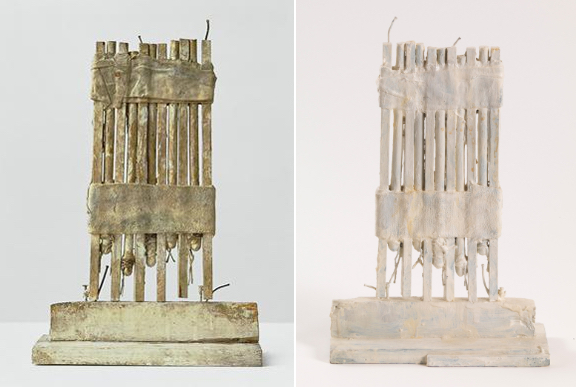
Actually, I don’t digress. Because the artworks in the background are what caught my eye this morning, and there is a 1953 Twombly sculpture next to Rauschenberg’s hip. That pan pipe sculpture *remained in the RRF collection until 2011, after which the Edlis Neesons of Chicago acquired it, and donated it to the Art Institute in 2015.* [The Broad has a painted bronze cast from a 1989 edition.] Twombly told Walter Hopps the tissue paper in Untitled (Paper Painting), the glass case behind Rauschenberg’s shoulder, came from shoe boxes.
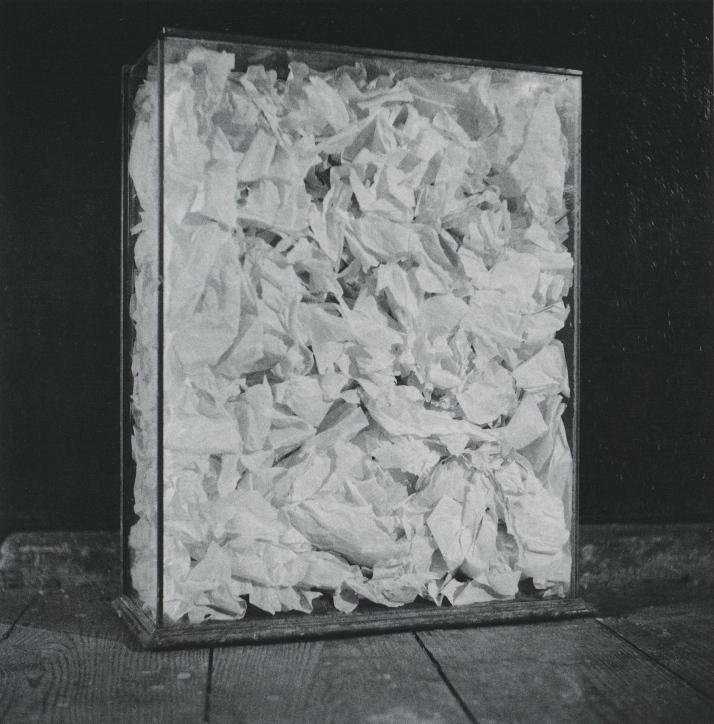
I am very interested in that dark, unframed painting resting on the tissues. I imagine the boys picked it up on the street, but it will require some further looking. That shelf has stuff, including what looks like a small white lead painting. But look down, next to the Twombly. The Twombly whose graduated reeds (upper right to lower left), along with Rauschenberg’s mole and part (right cheek, left side, respectively), makes me think that the photo should be flipped.
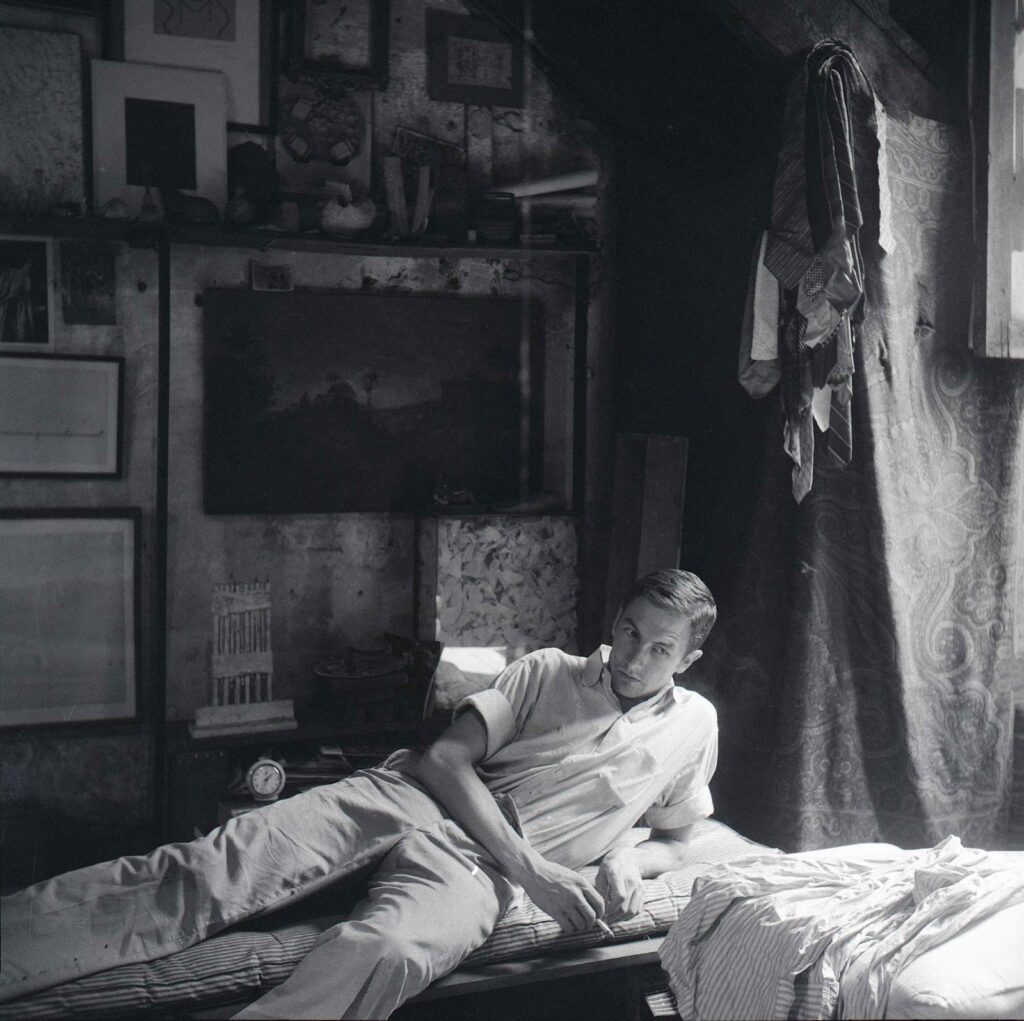
Now look at the unlabeled, unmatted, ungilded, framed work next to the Twombly. I think that is Erased deKooning Drawing.
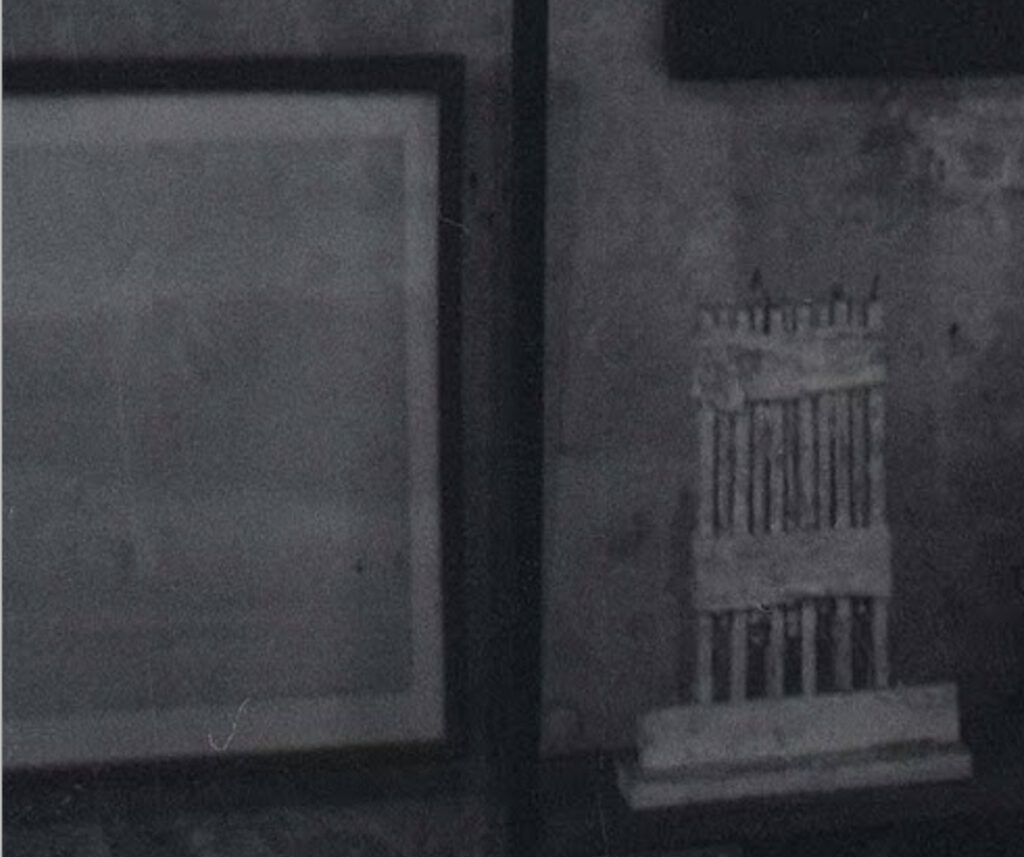
Those two dots along the lower right edge seem identical to me.
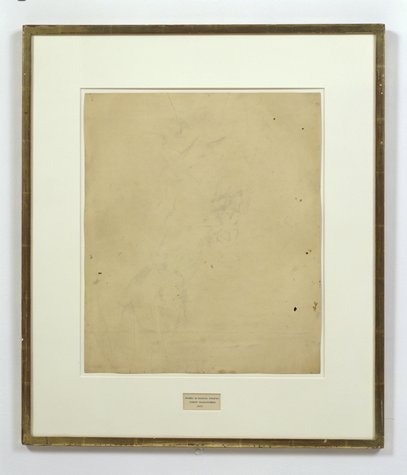
When I wrote [and wrote and wrote] about the changes over time to Erased deKooning Drawing, my initial focus was on how it was conceived, perceived, presented, and discussed. I was surprised to find out how much the physical form of the work had changed as well. I dutifully traced the differences in reported dimensions of the work—if this is deKooning’s original sheet of paper, it does seem to match the 16 3/4 x 13 3/8 in. dimensions Lawrence Alloway published for EdeKD in 1964 —but I could never find an image of the work before 1970. And no published reproduction of it before 1976.
But now we do.
[Actually, now we have at least two. In the years since I searched, SFMOMA published a 1961 Fred McDarrah photo of the Front St. Studio with EdeKD in its Johns collab, labeled, framed state.]
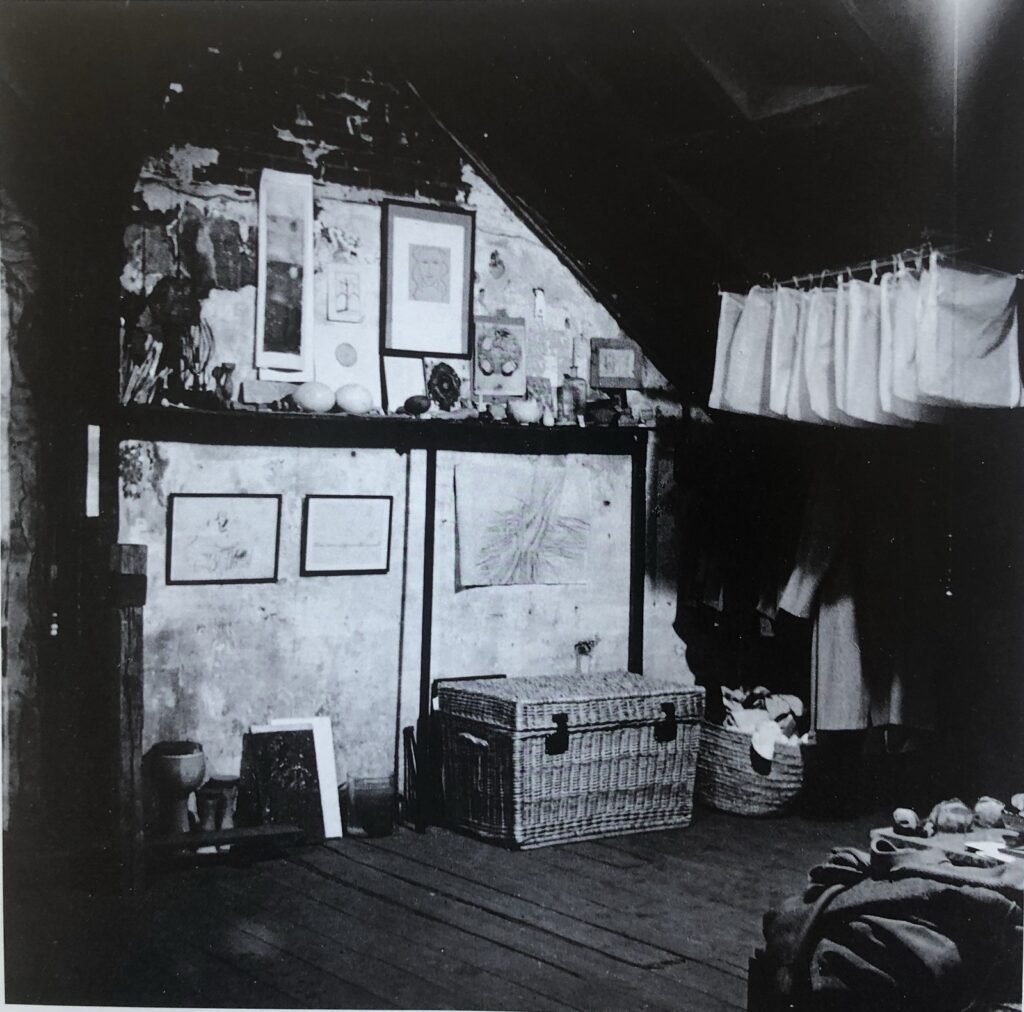
And now the location matches more clearly a c.1953 image from the catalogue of the The Early 1950s show, which Walter Hopps labeled, the “artist’s domestic alcove.” I think this is the earlier photo, and in the interval between these two photos, a paisley shawl was installed to enclose the hanging clothes. And the hanging “paper sculpture” that looks like handkerchiefs drying was moved and/or lost. But that thing with three oval-shaped objects in a circle is still next to what Hopps’ caption identifies as a Matisse lithograph.
That spiky Twombly drawing above the hamper is gone, but that piece with the horizontal line that’s in both photos, is that what Hopps means by “a Cage music score”? And does that mean that “a deKooning drawing” is next to it? So there is another. Did he get two at once? Was this photo before the erasure ask? And who decided which one to erase: Bob or Bill?
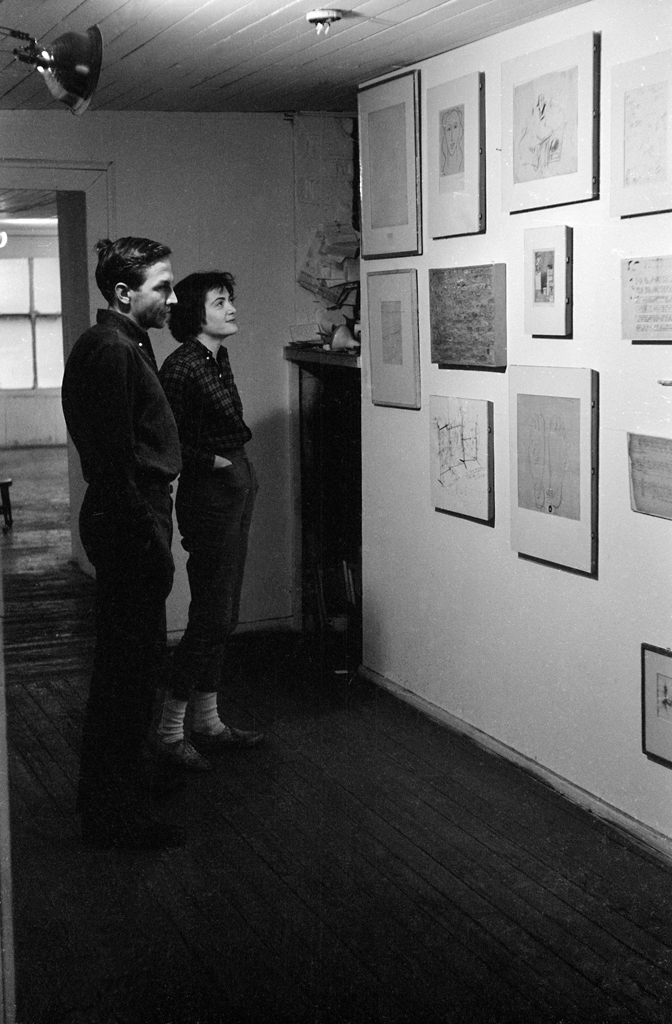
In fact, the top row of that SFMOMA photo from 1961 has both deKooning drawings, Erased and Unerased, with that Matisse in between. The Unerased deKooning Drawing, still in the Rauschenberg Collection, is dated to c. 1947-49. Sarah Roberts dates its acquisition to “later,” in context of Leo Steinberg quotes from 1957, McDarrah’s 1961 photo, and Calvin Tomkins references from 1964. Importantly, she also notes that this deKooning is “heavily worked by erasers.” But whether it’s “before” or “at the same time,” the 1953 pic from Hopps shows that this deKooning is “earlier,” and should be considered somehow in the context of EdeKD‘s creation.
In 2011-12 Johns told me that he’d suggested, and then worked on, the labeling and reframing of EdeKD for a group drawing show at Poindexter Gallery in Dec-Jan 1958-59. I think that date came from Fred Orton’s book, too. I asked Dore Ashton about it, who I said had reviewed that show for the Times. But the Rauschenberg Foundation cites SFMOMA and the Tworkov Estate dating the show to Dec-Jan 1955-56. The Johns/Orton timeframe had the show at the genesis of Poindexter’s launch in the former Egan Gallery space on 57th St, so I think the earlier, 1955-56 date makes more sense. Also that’s when Ashton reviewed it. It really takes some work to get these boys’ stories sorted out.
Anyway, point is, Erased deKooning Drawing looked one way on the wall of Rauschenberg’s Fulton Street studio. And it got its glowup very soon after Rauschenberg moved to 278 Pearl Street, where Johns lived, in the Fall of 1955.
[CORRECTION: Thanks to greg.org reader Jay for pointing out that this Twombly sculpture is now in the Art Institute of Chicago’s Edlis Neeson Collection. And is, in fact, on view right now. The post reflects the updated provenance.]
Related: Sarah Roberts’ 2013 Rauschenberg Research Project essay on Erased deKooning Drawing [sfmoma]
Rauschenberg Foundation Fulton Street chronology [rrf]
previously, unrelated: Untitled (Mnuchin Gallery), 2017
